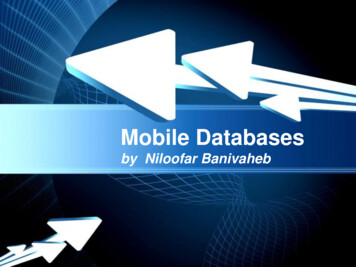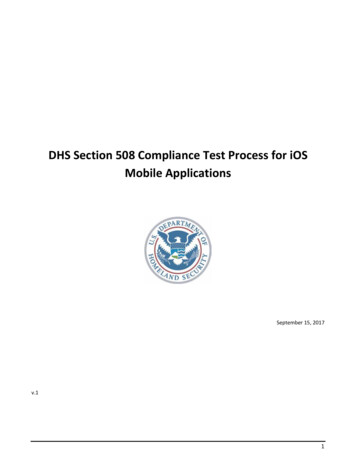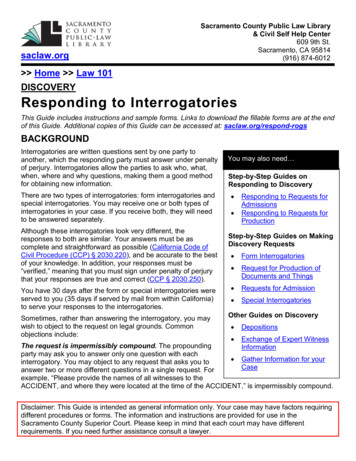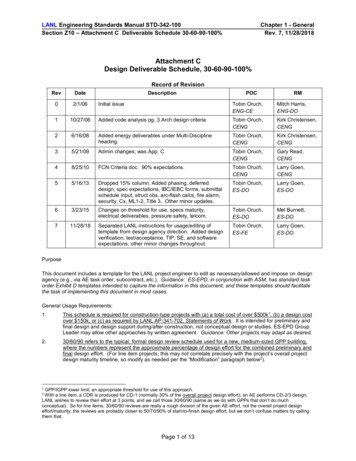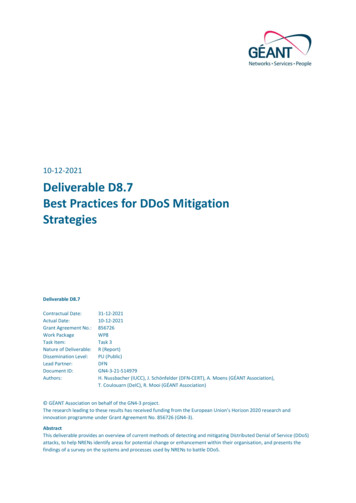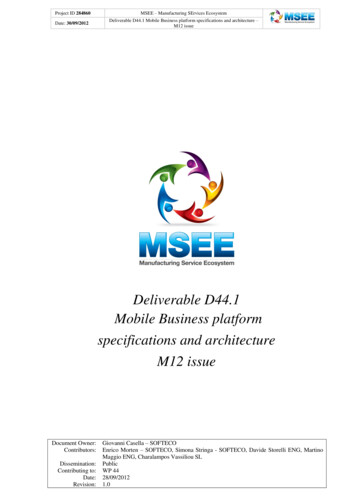
Transcription
Project ID 284860MSEE – Manufacturing SErvices EcosystemDate: 30/09/2012Deliverable D44.1 Mobile Business platform specifications and architecture –M12 issueDeliverable D44.1Mobile Business platformspecifications and architectureM12 issueDocument Owner:Contributors:Dissemination:Contributing to:Date:Revision:Giovanni Casella – SOFTECOEnrico Morten – SOFTECO, Simona Stringa - SOFTECO, Davide Storelli ENG, MartinoMaggio ENG, Charalampos Vassiliou SLPublicWP 4428/09/20121.0
Project ID 284860MSEE – Manufacturing SErvices EcosystemDate: 30/09/2012Deliverable D44.1 Mobile Business platform specifications and architecture –M12 issueVERSION HISTORYDATENOTES AND COMMENTS0.103/07/2012DELIVERABLE STRUCTURE ADDED0.205/07/2012SECTION 1 AND 2 ADDED0.311/07/2012SECTION 3 AND 4 ADDED0.419/07/2012SECTION 5 ADDED0.528/08/2012SECTION 6 AND 7 ADDED0.631/08/2012SECTION 8 ADDED0.718/09/2012SECTIONS 6.1 AND 6.2 REVISED0.820/09/2012SOFTECO INTERNAL REVIEW – DOCUMENT REVISION0.927/09/2012REVISION ACCORDING MSEE PEER REVIEW COMMENTS1.028/09/2012FINAL VERSIONDELIVERABLE PEER REVIEW SUMMARYIDCommentsAddressed ( )Answered (A)1Too many and deep technical details in some sections.Some technical details have beenremoved.234Section 6.1 is confusing (too many sw developmentSection 6.1 has been revised and retechnologies and approaches) and should be split instructured.more sub-sections.The Mobile Collaboration Module could also extendthe Operational/Ecosystem-governance Management System.The Multimodal Module should prioritize visual, This is the goal of the module. It hastouch and speech interaction instead than text.been highlighted in the text.MSEE ConsortiumDissemination: PU2/50
Project ID 284860MSEE – Manufacturing SErvices EcosystemDate: 30/09/2012Deliverable D44.1 Mobile Business platform specifications and architecture –M12 issueTABLE OF CONTENTSEXECUTIVE SUMMARY51.INTRODUCTION71.1.1.2.782.Objective of the DeliverableStructure of the DeliverableMOBILE DEVICES AND OPERATING SYSTEMS2.1.2.2.9Mobile DevicesMobile Operating Systems9113.RELEVANT TECHNOLOGIES144.THE ROLE OF THE MOBILE BUSINESS PLATFORM IN MSEE175.MOBILE BUSINESS PLATFORM216.MOBILE BUSINESS PLATFORM MODULES ile Development ModuleMobile Delivery ModuleAmbient Intelligence ModuleMobile Collaboration ModuleMultimodal ModuleCONCLUSIONS50LIST OF FIGURESFigure 1: Relevant MSEE deliverables for this document . 7Figure 2: Top-down approach used to structure the deliverable . 8Figure 3: Cell phones. 9Figure 4: PDAs . 10Figure 5: Smartphones . 10Figure 6: Tablets . 11Figure 7: App Store and Android Market. 13Figure 8: The MSEE Service System Life Cycle . 17Figure 9: Transitions among the servitization levels . 18Figure 10: MSEE IT System . 18Figure 11: The Service System Life Cycle. 19Figure 12: Mobile Platform Modules . 21Figure 13: REST Services and Mobile Applications . 24Figure 14: Mobile Development code generation process . 25Figure 15: Mobile Development Module . 26Figure 16: FI-WARE SDF high level architecture . 29Figure 17: Mobile Delivery Deployment Diagram . 30Figure 18: Mobile Delivery Module. 30Figure 19: Home and Manufacturing Environments . 34Figure 20: User, Environments and Devices . 36Figure 21: AMI Module . 37Figure 22: Barcode . 41Figure 23: QRCode. 42Figure 24: Application and environment sensing . 49MSEE ConsortiumDissemination: PU3/50
Project ID 284860MSEE – Manufacturing SErvices EcosystemDate: 30/09/2012Deliverable D44.1 Mobile Business platform specifications and architecture –M12 issueLIST OF TABLESTable 1: Report on mobile operating systems diffusion . 12Table 2: Mapping of the MSEE IT Platforms with the phases of the Service System LifeCycle . 20MSEE ConsortiumDissemination: PU4/50
Project ID 284860MSEE – Manufacturing SErvices EcosystemDate: 30/09/2012Deliverable D44.1 Mobile Business platform specifications and architecture –M12 issueExecutive SummaryThis document describes the initial specification and architecture of the MSEE MobileBusiness Platform (Mobile Platform) resulting from the work done, in the first six months, inWP44 “MSEE Generic Mobile Business Platform”.The task T44.1 of WP44 “Support to Mobile and Ubiquitous business” focuses on theexploitation of the ubiquitous computing environment provided by mobile devices in order tosupport business scenarios with personalised services utilized by users in mobility, and inorder to support industrial model for Innovation Ecosystems enhancing mobile collaboration.To achieve the goal of T44.1 the Mobile Platform provides mobile extension to other MSEEplatforms namely the MSEE Generic Development Platform (WP42), the MSEE GenericService Delivery Platform (WP43) and the Innovation Ecosystems Platform (WP26).In addition to extending other platforms, the Mobile Platform addresses two relevant topicsfor mobile devices namely Multimodal Interaction and Ambient Intelligence.The task T44.2 focuses “on the study and the implementation of new multi-modal userinteraction models, based on adaptive interfaces, which may use visual and speechcommunication, natural-language recognition of free text, speech or gestures” [MSEE DoW1].The Mobile Platform addresses this topic applying a multimodal adaptive interface to aconcrete mobile application to be used in a manufacturing context. One of the main goals ofthe multimodal adaptive interface is to assess the advantages of a multimodal interface whenused by professionals involved in multiple tasks at the same time and working in a changingenvironment with particular characteristics (i.e. noisy, brightly, dangerous, etc.).Finally the task T44.3 addresses the innovative scenarios enabled by the Ambient Intelligenceissue in the context of MSEE use cases and end-users. The Mobile Platform exploits theengaging features of smartphones and tablets in order to discover and identify the availabledevices (machines, sensors, etc.) in the user environment providing additional functionalitiesfor these devices. Moreover the platform provides a simple extension mechanism enablingdevelopers to extend the general features of the system in order to address domain specificrequirements.The deliverable is organized as follows:Section 1 – Introduction: clarifies the objective of the deliverable, its internal structure and therelations with other MSEE deliverables relevant for this document.Section 2 – Mobile Devices and Operating Systems: provides some background informationon mobile devices (cell phones, PDAs, smartphones, tablets) and their operating systems.Section 3 – Relevant Technologies: presents, very briefly, the technologies that will be usedto develop the Mobile Platform in order to simplify the reading of the subsequent sections.Section 4 – The role of the Mobile Business Platform in MSEE: specifies the role of theMobile Platform in the context of the Service System Life Cycle composed by the“servitization process” and by the “governance and innovation process” and highlights theposition of the Mobile Platform in the MSEE IT System2.Section 5 – Mobile Business Platform: presents the general architecture of the platform andintroduces its modules.Section 6 – Mobile Business Platform Modules Specification: depicts the internal architectureof each module and presents its specification.12MSEE DOW: Manufacturing SErvice Ecosystem Description of WorkMSEE D41.1: MSEE Service-System Functional and Modular ArchitectureMSEE ConsortiumDissemination: PU5/50
Project ID 284860MSEE – Manufacturing SErvices EcosystemDate: 30/09/2012Deliverable D44.1 Mobile Business platform specifications and architecture –M12 issueSection 7 – Conclusions: summarizes the results presented in this document and describes thework to be done in order to implement the initial platform prototype and to define the finalversion of the specification.The specification presented in this document (D44.1) will be implemented in the initialprototype of the Mobile Platform (D44.3). Next, the document will be refined and extended toobtain the final specification and architecture of the Mobile Platform (D44.2) that will be thebase for the final prototype (D44.4).MSEE ConsortiumDissemination: PU6/50
Project ID 284860MSEE – Manufacturing SErvices EcosystemDate: 30/09/2012Deliverable D44.1 Mobile Business platform specifications and architecture –M12 issue1. Introduction1.1.Objective of the DeliverableThe main objective of this deliverable is to introduce the MSEE Mobile Business Platform:Providing a short background on mobile devices and related technologies andproviding some links to get further information.Highlighting the role of the platform in the MSEE project and describing the relationswith the others platforms developed in the project.Presenting the Mobile Platform initial architecture and specification.The document presents the results obtained in the WP44 of MSEE namely “MSEE GenericMobile Business Platform” and in particular in the three workpackage tasks T4.4.1 “Supportto Mobile and Ubiquitous business”, T4.4.2 “Multimodal Interaction” and T4.4.3 “AmbientIntelligence”.D41.1: MSEE ServiceSystem Functional andModular ArchitectureD52.1: User RequirementsAnalysis for VirtualFactories & Enterprises inMSEED26.1: InnovationEcosystem platformSpecifications andarchitectureD42.1: Generic ServiceDevelopment Platformspecifications andarchitectureD44.1: Mobile BusinessPlatform specificationsand Architecture (initial)D43.1: Service DeliveryInfrastructure specificationsand architectureD44.3: Mobile Businessplatform first prototypeD44.2: Mobile BusinessPlatform specificationsand Architecture (final)D44.4: Mobile Businessplatform final prototypeFigure 1: Relevant MSEE deliverables for this documentFigure 1 presents the MSEE deliverables with a particular relevance for this document. TheMobile Platform is part of the MSEE IT System presented in D41.1 and address the first set ofuser requirements collected in D52.1.The Mobile Platform focuses on mobile devices extending the other MSEE platformscomposing the MSEE IT System, whose initial specification is provided in the deliverablesD26.1, D42.1 and D43.1.MSEE ConsortiumDissemination: PU7/50
Project ID 284860MSEE – Manufacturing SErvices EcosystemDate: 30/09/2012Deliverable D44.1 Mobile Business platform specifications and architecture –M12 issueThe architecture and specification presented in this document will be used to develop theMobile Platform first prototype (D44.3). This document will be refined and extended todefine the final version of the Mobile Platform architecture and specification (D44.2).Finally the final prototype of the platform (D44.4) will be developed as described in the finalspecification of the platform and starting from the initial prototype.1.2.Structure of the DeliverableTo improve readability, the document presents the information regarding the Mobile Platformfollowing a top-down approach both for the overall document and inside each section. Firstlygeneral information is presented, and afterwards specific information and/or technical detailsare provided.GeneralSection 1Section 2Section 3 Section 4Section 5Section 6.1Section 6Section 6.2Section 7Section 6.3Section 6.3.1Section 6.3.2 Specific /TechnicalFigure 2: Top-down approach used to structure the deliverableFigure 2 shows a graphical representation of this approach. While Section 3 and 4 includessome general background information on mobile devices and mobile relevant technologiesSection 5 depicts the role of the Mobile Platform in MSEE and Section 6 and 7 present theplatform specification and architecture.The top-down approach is used also in each Section.For example Section 6 presents the specification of the Mobile Platform modules, Section 6.3presents the details of a particular module and Section 6.3.1 includes some technicalinformation on a specific aspect of the module.Having simpler contents, Section 1 “Introduction” and Section 7 “Conclusions” do not followthe top-down approach.MSEE ConsortiumDissemination: PU8/50
Project ID 284860MSEE – Manufacturing SErvices EcosystemDate: 30/09/2012Deliverable D44.1 Mobile Business platform specifications and architecture –M12 issue2. Mobile Devices and Operating Systems2.1.Mobile DevicesIn the last years the mobile device market has shown an exponential grow and newtechnologies have generated a great excitement. In addition to the original cell phones todayseveral devices are available such as PDAs, smartphones, tablets, notebooks, laptops,handheld game console, portable media player, personal navigation device and so on.Some of these mobile devices (i.e. game console, portable media player, personal navigation)are out of the scope of the Mobile Platform. Also laptops and notebooks will not be addressedby the Mobile Platform because they are able to execute applications designed for PersonalComputer so they can use functionalities provided by the other MSEE platforms.In the rest of the Section will be presented some candidate device categories to be addressedby the Mobile Platform while the precise set of addressed devices is defined in the last part.Cell PhonesThe first models of cell phones (Figure 3) where developed during the first half of the 20thcentury. They were very expensive devices, weighting more than 30 kilos, and their use waslimited to demonstrations and to military uses during the Second World War. The uniquepurpose of these phones was to send and receive voice communications.Modern cell phones were developed around 1990. They were quite expensive small devicesequipped with an alpha numeric display where the main feature was again to send and receivevoice communications. However the rapid expansion of the mobile phone market promotedthe addition of new features.Today cell phones can be small or medium sized and are equipped with a graphical colordisplay and a numeric physical keyboard (sometime a qwerty physical keyboard). Newfunctionalities have been added like the possibility to send and receive text and multimediamessages (SMS and MMS) and to capture low resolution photo. A predefined set ofapplications (i.e. phone book, calculator, convertor, games, alarm, etc.) is pre-installed onthese devices. To find and install new applications is quite complex.Figure 3: Cell phonesPersonal Digital Assistant (PDA)PDAs (Figure 4) are medium sized devices usually equipped with a medium/large graphicaldisplay. Their main purpose of PDAs is to help the user in the management of personalinformation like addresses, contacts, task lists, appointments, meetings, reminders, etc.The main PDA input method is usually a resistive touch screen to be used with a stylus. Whilesome PDAs are equipped with a physical QWERTY keyboard the major part are equippedwith a virtual qwerty keyboard.Traditionally PDAs did not provide communication features like telephone/fax, Internet andnetworking. While cell phones are still on the market due to their price (today they are quiteMSEE ConsortiumDissemination: PU9/50
Project ID 284860MSEE – Manufacturing SErvices EcosystemDate: 30/09/2012Deliverable D44.1 Mobile Business platform specifications and architecture –M12 issuecheap) and features (they are usually small and simple to use) PDAs have been largelyreplaced by smartphones.Figure 4: PDAsPDAs are equipped with a predefined set of applications that it is difficult to expand while itis easy to synchronize the PDA contents (calendar, address book, etc.) with the contentsstored on a Personal Computer.SmartphoneSmartphones (Figure 5) can be considered a combination of cell phones and PDAs. In factthey are able to manage personal information and to provide GSM (Global System for MobileCommunications) communication capabilities.Today the main focus is on smartphones (and on tablet presented later) and everyday newmodels (with new features) appear on the market.Smartphones are pocket sized devices bigger than a cell phone and similar to PDAs. Theirdisplay is usually a high resolution graphical display supporting multi touch (even if in somecases they are still equipped with a qwerty physical keyboard). The display is not resistive (asin PDA requiring a stylus) but capacitive enabling a comfortable and precise use using onlyfingers.Smartphones are equipped with powerful CPUs (over 1Ghz of speed, sometime dual-core)and have a large storage space (some gigabytes). They are able to detect their precise locationusing the Global Position System and to sense the ambient through several sensors(luminosity sensor, accelerometer, digital compass). Finally smartphones are able to guaranteehigh speed internet access and other communication channels like Wi-Fi and Bluetooth.Figure 5: SmartphonesSmartphones are sold with a large pre-defined set of applications easy to expand. Finding newapplications is fast and simple thanks to the availability of dedicated virtual marketplaces ofmobile applications.TabletTablets (Figure 6) are portable devices quite big (they are usually equipped with a 7’-10’display) in comparison to smartphones and cell phones but they are usually lighter andsmaller than a notebook.MSEE ConsortiumDissemination: PU10/50
Project ID 284860MSEE – Manufacturing SErvices EcosystemDate: 30/09/2012Deliverable D44.1 Mobile Business platform specifications and architecture –M12 issueFigure 6: TabletsThey have a large multi-touch capacitive touch screen and are able to execute bothapplications implemented for smartphones and applications specifically developed for tabletsable to fully exploit tablet’s features (in particular their large screen) and ensuring animproved user experience. As smartphones, tablets have many communication capabilities(GSM, Bluetooth, Wi-Fi), support GPS, are equipped with several sensors and are soldincluding many applications. It is possible to add new applications easily exploiting availablemobile application marketplaces.Devices addressed by the Mobile PlatformDue to their engaging features and diffusion the main categories of mobile devices addressedby the MSEE mobile platform are smartphones and tablets. They are high technology devices,sold at an accessible price, including state of the art technologies in the mobile device field.Suitable operating systems and powerful programming languages exist for such devices andusers are able to easy find new applications and to install them in a user-friendly way.Finally they are equipped with powerful CPU (less powerful than CPU equipping notebooksbut really powerful respect to CPU embedded into cell phones and PDAs) and have a largestorage space.2.2.Mobile Operating SystemsToday the general feeling is that the mobile operating systems provided by Google (leadingthe Open Handset Alliance) and Apple are dominating the market and this feeling isconfirmed, among others, by a recent press release published by comScore3 in April 2012 (seeTable 1) highlighting the most spread mobile operating systems.3http://www.comscore.com/About comScoreMSEE ConsortiumDissemination: PU11/50
Project ID 284860MSEE – Manufacturing SErvices EcosystemDate: 30/09/2012Deliverable D44.1 Mobile Business platform specifications and architecture –M12 issueTop Smartphone PlatformsSource: comScore MobiLensShare (%) of Smartphone SubscribersJan-12Apr-12Point 4Table 1: Report on mobile operating systems diffusionThe Open Handset Alliance provides the Android platform, a Linux-based operating systemfor mobile devices (i.e. smartphones and tablet computers) of different manufacturers.Android applications are written in Java (a customized version) and several tools and librariesare available. Android makes easy to write engaging applications through the provision ofpowerful APIs with different goals like handset layouts management, internal storage use,connectivity management (bluetooth, Wi-Fi, etc.), access to phone messaging and calls, mediasupport (audio/video), multi-touch support, etc.Apple provides the IOS platform equipping Apple devices like iPhone and iPad.iOS applications are written in Objective-C using the Cocoa framework. Even for iOS apowerful development environment is available, namely xcode, as well a complete API and aset of additional libraries.RIM provides the operating system (a proprietary multitasking environment) equippingworldwide known BlackBerry devices.Microsoft provides the Windows Phone operating system (the successor of the WindowsMobile platform) and is trying to conquer the mobile market through an alliance with Nokia.However Windows Phone operating system, launched in the second half of 2010, has still asmall diffusion (4%).Finally Symbian, that today is not very diffused, was the most advanced and used operatingsystem before the comparison of smartphones and equipped million of Nokia cell phones.Android and iOS have defeated the competitors thanks to their unique features and inparticular to the features dedicated to the installation of new applications.In fact users are able to access to online markets (i.e. App Store and Android market shown inFigure 7) directly by their phones and they can easily choose an application (from thethousands of free and not-free applications available) or a game to install on it. The downloadand installation of the applications is really simple while developers are fully supported interms of tools and documentation.4http://www.comscore.com/Press Events/Press Releases/2012/6/comScore Reports April 2012 U.S. Mobile Subscriber Market ShareMSEE ConsortiumDissemination: PU12/50
Project ID 284860MSEE – Manufacturing SErvices EcosystemDate: 30/09/2012Deliverable D44.1 Mobile Business platform specifications and architecture –M12 issueFigure 7: App Store and Android MarketThe main difference between iOS and Android is that iOS is installed only on Apple devices,while Android is installed on the devices of many brands like HTC, Samsung, LG, Sony etc.It is clear that the iOS diffusion is related to the diffusion of Apple products while thediffusion of Android is not related to the products of a specific brand. Moreover while Appleproducts are quite expensive other brands sell expensive devices but also cheap ones.Another key difference between Android and iOS is that while Android is open source(supported by the Open handset Alliance) and it is possible to develop an Android applicationusing a generic personal computer, iOS is an Apple proprietary system and a MAC computeris required to develop an iOS application.In most cases the functionalities of the Mobile Platform will be available to smartphones andtablets regardless of their operating systems while when a strictly interaction between theplatform and the mobile device hardware will be required, a native application, specificoperating system dependent,will be developed. In this latter case the addressed operatingsystem will be Android mainly due to its diffusion but also to its open source nature.MSEE ConsortiumDissemination: PU13/50
Project ID 284860MSEE – Manufacturing SErvices EcosystemDate: 30/09/2012Deliverable D44.1 Mobile Business platform specifications and architecture –M12 issue3. Relevant TechnologiesThis Section provides some general information on the relevant technologies for the MobilePlatform. While the descriptions are short and concise a web site is indicated for eachtechnology where the reader can find additional details if needed.Ajax5AJAX is the acronym of Asynchronous JavaScript and XML and indicates a particulartechnique to exchange data with a server enabling to update parts of a (mobile) web pagewithout reloading the whole page. In practice Javascript is used, on the browser, to interactwith the server and to update the web page shown to the user while XML is used as dataformat to exchange data between the server and the browser.Android6Android is an open source operating system for mobile devices installed on many mobiledevices of almost all manufacturers (the Android presence on the market is increasinglyconstantly). The Android features, the presence of a vibrant community around thetechnology, the availability of documentation (books, developer manuals, tutorials, videos,etc.) and the availability of the Android application market enables developers to produceengaging applications that users can easily find and download.The Android ADT is a powerful Eclipse plug-in supporting developers to implement mobileapplications.Apache HttpComponents7The Apache HttpComponents library is provided by Apache with the goal of simplifying Javabased developmentsexploiting the HTTP protocol.Designed for extension while providing robust support for the base HTTP protocol, theHttpComponents library is of interest for building HTTP-aware client and server applicationssuch as web browsers, web spiders, HTTP proxies, web service transport libraries, or systemsthat leverage or extend the HTTP protocol for distributed communication.Apache Jersey8Apache Jersey is an open source framework supporting developers in the provision of RESTweb services and representing the reference implementation of the JAX-RS (JSR 311)specification. The specification defines a set of Java APIs for the development of Webservices built according to the Representational State Transfer architectural style.Eclipse IDE9Eclipse is a powerful and extensible integrated development environment, including runtimesand application frameworks, for building, deploying and managing software across the entiresoftware p://jersey.java.net/9http://www.eclipse.org6MSEE ConsortiumDissemination: PU14/50
Project ID 284860MSEE – Manufacturing SErvices EcosystemDate: 30/09/2012Deliverable D44.1 Mobile Business platform specifications and architecture –M12 issueHTML is a markup language for structuring and presenting content for the World Wide Weband HTML5 represents the fifth revision of the HTML standard (created in 1990 andstandardized as HTML4 as of 1997). HTML5 is still under development (as August 2012) andits goal is to improve HTML4 supporting the latest multimedia formats as well as locationservices while keeping it easily readable by humans and consistently understood bycomputers and devices.Javascript 11JavaScript is a lightweight scripting language supported by all major browsers. UsuallyJavascript is embedded in HTML pages and using it is possible to ask the browser to performsome actions like to check if a required form field has been left empty.JQuery Mobile 12The JQuery Mobile framework is designed to support developers in the implementation ofweb sites, designed to be used by mobile devices regardless by device features (screendimension and density, available input modes, etc.) and device operating systems.JQuery Mobile provides a unified user interface system that works seamlessly across allpopular mobile device platforms.The framework includes an Ajax navigation system that brings animated page transitions anda core set of User Interface widgets.JSON13JSON (JavaScript Object Notation) is a lightweight textual data-interchange format that iseasy to read and write for humans and machines. Although JSON is based on a subset of theJavaScript Programming Language it is completely independent by any programminglanguage or operating system. JSON is widely used to represent resources exchanged byREST web services.REST14REST is the acronym of REpresentational State Transfer and denotes a particular type ofsoftware architecture for distributed systems (client/server) adopted by the World Wide Web.In a REST architecture clients send requests to servers that return an appropriate resource. Inthe World Wide Web the client role is played by the
Mobile Platform first prototype (D44.3). This document will be refined and extended to define the final version of the Mobile Platform architecture and specification (D44.2). Finally the final prototype of the platform (D44.4) will be developed as described in the final specification of the platform and starting from the initial prototype.




